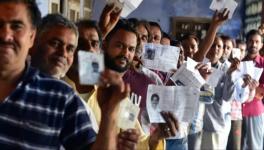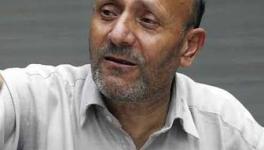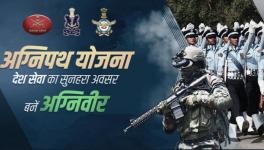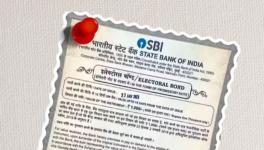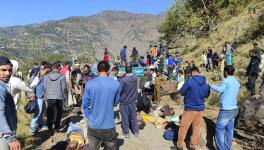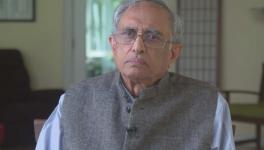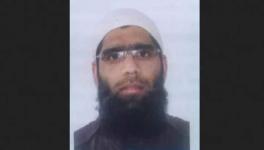Explained: Never-Ending Promises of AFSPA Revocation in J&K
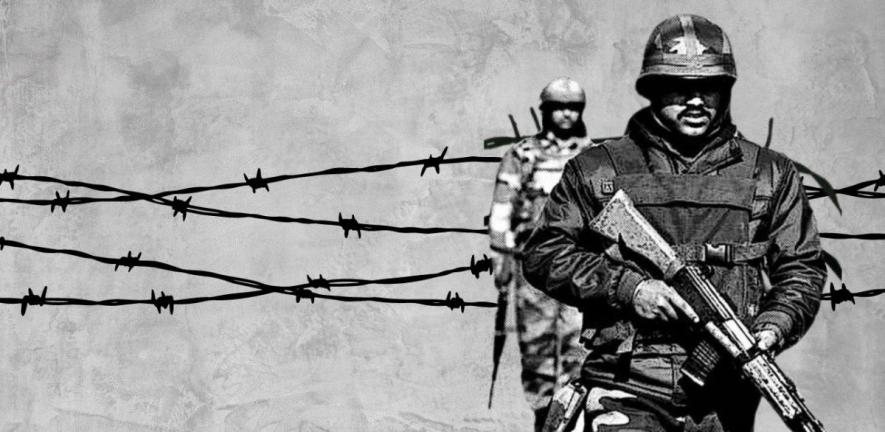
Image Credit: The Leaflet
In a recent interview, Union Home Minister Amit Shah claimed that the government is planning to revoke the Armed Force (Jammu and Kashmir) Special Powers Act, 1990 (JKAFSPA).
Shah told Gulistan News, a local news portal in J&K: “The situation is getting normal [after the end of the autonomy granted to J&K under Article 370]. We are considering revocation of (JK)AFSPA.”
He added: “The government has already drawn a roadmap for the withdrawal of troops and the process will be initiated after [the general] elections.”
History of AFSPA
AFSPA has its roots in the British-era Armed Forces (Special Powers) Ordinance, promulgated on August 15, 1942 to suppress the ‘Quit India Movement’.
The ordinance gave special powers to commissioned and non-commissioned officers to use maximum force, even to the extent of causing death, to deal with an emergency situation, such as to contain mass anti-colonial protests and sentiments. It granted absolute immunity to their acts from criminal prosecution, except on the prior approval of the government.
Subsequently, in 1947, the Union government of newly independent India promulgated four ordinances to deal with conflict-affected areas as a result of the Partition riots. These were: the Bengal Disturbed Areas (Special Powers of Armed Forces) Ordinance, the Assam Disturbed Areas (Special Powers of Armed Forces) Ordinance; the East Bengal Disturbed Area (Special Powers of Armed Forces) Ordinance; and the United Provinces Disturbed Areas (Special Powers of Armed Forces) Ordinance.
In 1948, the Armed Forces Special Powers Act was enacted, which replaced all four ordinances. This legislation was based on the 1942 ordinance. The Act was repealed in 1957, only to be resurrected the next year to facilitate suppression of the Naga armed rebellion.
On May 22, 1958, the Armed Forces (Assam and Manipur) Special Powers Ordinance was promulgated. Later, this ordinance was replaced by The Armed Forces (Special Powers) Act (AFSPA), 1958.
While introducing the Bill, the then Union Home Minister Govind Ballabh Pant termed AFSPA “a very simple measure” to control the “misguided Nagas indulging in mischievous activities”.
During the parliamentary debate on AFSPA, a member of Parliament from Manipur, Laishram Achaw Singh, described it as a “lawless law” and stated it would only be used to “harass innocent folks” and resultantly “deteriorate the situation”.
Another member Surendra Mohanty, warned against the promulgation of AFSPA, stating that it invokes a state of emergency where constitutional rights, including the right to approach the court, are suspended.
He said: “We want a free India. But we do not want a free India with barbed wires and concentration camps, where havaldars can shoot at sight any man. If that is the concept of free India, I think I may as well be a traitor.”
However, the first prime minister of independent India, Jawaharlal Nehru, had defended the law.
He asserted: “No infirm government can function anywhere. Where there is violence, it has to be dealt with by the government, whatever the reason for it may be; because otherwise you drift; the country drifts into, if I may use the word, fascist methods, all groups, private groups and others, indulging in violence and trying to coerce the governmental authority by organised violence.”
Powers under AFSPA
Section 3 of AFSPA empowers the governor of any state, administrator of a Union territory, or Union government to declare parts of or a whole state or Union territory as a “disturbed area” if they are of the “opinion” that there exists “disturbed or dangerous condition that the use of armed forces in aid of the civil powers is necessary”. The legislation does not provide any definition of ‘disturbed’ or ‘dangerous condition’.
In Inderjit Barua versus State of Assam (1983), the petitioners challenged the constitutionality of the 1958 Act as being violative of Articles 19 (protection of certain rights regarding freedom of speech, etc) and 21 (protection of life and personal liberty) of the Indian Constitution.
Another issue raised by them was that the act of notifying disturbed areas by the governor is arbitrary because it is issued without the application of mind, without any proper material being produced before the governor. While upholding the constitutionality of the legislation, the Delhi High Court held that the governor’s notification cannot be considered arbitrary just because there are no legislative guidelines.
Section 4 of AFSPA describes the powers that could be exercised by armed forces. In disturbed areas, the armed forces are given carte blanche to use force, after giving due warning, even to cause death, if a member of the armed forces “is of the opinion” that any person is acting in contravention of any law or order for the time being in force the disturbed area prohibiting assembly of five or more persons, the carrying of weapons, or things capable of being used as weapons or firearms, ammunition or explosive.
The armed forces are also given the power to destroy any structure if “in their opinion” it is used as an arms dump, training camp for armed volunteers, or utilised as a hide-out by armed gangs or absconders wanted for any offence.
They can arrest without warrant any person who has committed a cognisable offence or against whom a reasonable suspicion exists that he has committed or is about to commit a cognisable offence. The armed forces may use force as may be necessary to effect the arrest.
The armed forces can enter and search without warrant any premises or recover any person believed to be wrongfully restrained or confined or any property reasonably suspected to be stolen property or any arms, ammunition or explosive substance believed to be unlawfully kept in such premises.
These powers are of a very wide sweep and have been criticised by Indian and international rights groups for being arbitrary and excessive. The most serious criticism has been that they put too much emphasis on the ‘opinion’ and ‘discretion’ of the armed forces, and violate basic principles of the rule of law.
However, courts in India have generally been partial towards the powers granted to armed forces under AFSPA, using the rationale of ‘national security’.
In Inderjit Barua, the court held that conferring powers to non-commissioned officers such as the havaldar cannot be said to be bad and unjustified.
Section 5 of the Act says that any person must be arrested and taken into custody shall be made over to the officer in charge of the nearest police station with the least possible delay, together with a report of the circumstances occasioning the arrest.
In Luithukia versus Rishang Keishing (1988), the Gauhati High Court interpreted Section 5 of AFSPA. The court emphasised the role played by the district administration. It was stated that the civil authorities and the armed forces have to work hand in glove and not in suppression of any side. The court said: “The armed forces must act in cooperation with the district administration and not as an independent body.”
In Horendi Gogoi versus Union of India (1991), the Gauhati High Court held that the obligation under Section 5 to hand over the person to the officer-in-charge of the nearest police station without the least possible delay is mandatory.
Section 5 is an exception to the safeguards available to a person arrested under the Code of Criminal Procedure (CrPC). Under the CrPC, a person can be arrested without a warrant for cognisable offence. But he cannot be detained for more than 24 hours in police custody as per Section 54 of the CrPC. This is also a fundamental right available under Article 22(2) of the Indian Constitution.
If the police officer requires more time for investigation, the accused person should be produced before the magistrate for further custody under Section 167 (procedure when investigation cannot be completed within twenty-four hours) of the CrPC.
One of the most contentious provisions of AFSPA is the absolute immunity against criminal prosecution under Section 6 unless the Union government approves a sanction to prosecute.
While the 1958 Act has seven provisions, JKAFSPA has eight provisions with modifications.
Section 3 of JKAFSPA details the situations in which an area shall be declared disturbed area. It includes activities involving terrorist acts directed towards overawing the government, striking terror in the people, or any section of the people, alienating any section of the people or adversely affecting the harmony amongst different sections of the people.
Further, it includes activities directed towards disclaiming, questioning or disrupting the sovereignty and territorial integrity of India or bringing about the cession of a part of the territory of India or secession of a part of the territory of India from the Union or causing insulting to the Indian national flag, the Indian national anthem and the Indian Constitution.
Section 4 of JKAFSPA gives additional powers to armed officers to also stop, search and seize any vehicle or vessel reasonably suspected to be carrying any person who is a proclaimed offender, or any person who has committed a non-cognisable offence, or against whom a reasonable suspicion exists that he has committed or is about to commit a non-cognisable offence.
An additional provision, Section 5, has been added to JKAFSPA which allows every person making a search to have the power to break open any door, almirah, safe, box, cupboard, drawer, package or any other thing, if the key thereof is withheld.
Along with AFSPA, the Jammu & Kashmir Public Safety Act, 1978 empowers the police to detain a person for a maximum period of two years without any charge or trial if the person’s action is prejudicial to the security of the State.
The combined effect of the stringent laws is such that it creates a state of exception where fundamental rights protection under Articles 19 and 21 are not available.
In India, emergencies, including a National Emergency, are proclaimed by the President under Article 352 of the Indian Constitution on the aid and advice of the Union cabinet. During an Emergency, all fundamental rights could be suspended except Articles 20 and 21 as per the 44th constitutional amendment.
Many scholars write that AFSPA empowers the executive to proclaim an undeclared Emergency, where fundamental rights, including the right to life effectively, are suspended.
Further, while an Emergency is declared for a definite period of time, AFSPA continues to be extended for an indefinite period.
Recently, the Union Ministry of Home Affairs (MHA) extended AFSPA in Arunachal Pradesh and Nagaland, while the Assam government issued a notification for extending it in certain districts.
In certain states such as Assam, Manipur and Nagaland, the territory categorised as ‘disturbed areas’ has decreased due to significant improvements in the security situation.
As per a statement by the Union home ministry, “Compared to the year 2014, there is a reduction of 76 percent in the extremist incidents in the year 2022. Similarly, deaths of security personnel and civilians have come down to 90 percent and 97 percent during this period.”
AFSPA was revoked in Tripura in 2015 and in Meghalaya in 2018 after 15 and 27 years respectively.
Why was AFSPA needed in J&K?
When British rule ended in the sub-continent in 1947, giving birth to India and Pakistan, Kashmir was one of the 584 Princely States that existed under British suzerainty in the subcontinent. These Princely States were given a choice to join either of the two countries. With a significant Muslim majority, J&K was likely to join Pakistan, given the logic of the Partition on communal lines.
However, J&K was peculiar in that it was a Muslim-majority State ruled by a Hindu king. The king wanted to remain independent but after a series of massacres by his forces in the Jammu region led tribal partisans from Pakistan to pour into J&K, he hastily signed an instrument of accession, hitching J&K to India.
At that time, a huge Quit Kashmir movement against the king was ongoing, and after the sudden accession to India and India’s first Prime Minister Jawaharlal Nehru promising to hold a plebiscite in the region to determine its future, the movement turned into a movement for plebiscite and self-determination.
Successive Indian governments failed to fulfil the promise of a plebiscite and rigged local and state assembly elections to ensure that the pro-Pakistan and pro-Independence constituencies in J&K, significantly outnumbering the pro-India constituency, did not come to power.
By the late 1980s, frustrated by the wait and the broken promises, a new generation of youth in J&K started an armed rebellion against Indian rule.
It was to facilitate the crushing of this rebellion that JKAFSPA was instituted in 1990. So, in essence, it was part of a military solution to what is fundamentally a political problem.
What are the consequences of AFSPA?
Jammu & Kashmir Coalition of Civil Society is the only functional organisation in J&K that documents human rights abuses by armed forces and militants belonging to various local and Pakistan-supported outfits.
As per a report of the organisation, titled State of Human Rights in Jammu and Kashmir 1990-2006, the death toll of civilians for the period between 1990–2004 has been more than 70,000. Indian government’s official figures put the death toll between 1990 to 2005 at 47,000.
A 2012 report, Alleged Perpetrators: Stories of Impunity in Jammu and Kashmir identifies more than 500 perpetrators, mostly armed force personnel, responsible for extrajudicial killings. The report showcases the culture of impunity enjoyed by the armed forces.
The report states: “The defining feature of human rights violations in the last 22 years in Jammu and Kashmir is that in the name of countering militant violence the Indian State authorises armed forces to carry out every kind of operation, with or without adherence to laws and norms. Significantly, in a majority of cases crimes are not noted or investigated at all.”
The report discloses that not a single request for sanction for prosecution under AFSPA has been granted in 22 years.
About court-martials, the report states that they lack transparency and appear to be highly prejudicial in favour of accused armed forces personnel. This could be better understood from the recent suspension of the conviction of armed forces personnel in the infamous Shopian fake encounter.
The report states that the institutional culture of moral, political and judicial impunity has resulted, since 1990, in enforced and involuntary disappearances of at least 8000 persons, besides 70,000 deaths, and disclosure of more than 6,000 unknown, unmarked, and mass graves.
A 2009 report Buried Evidence: Unknown, Unmarked, and Mass Graves in Indian-Administered Kashmir by the International People’s Tribunal on Human Rights and Justice in J&K reiterates the statistics.
The report on unmarked mass graves states: “The graves, their creation and effect, belong to the present history of Kashmir, to a continuing chronicle of violence and violation. The graves are hyper-present in the local imagination but rarely spoken of in public. These ‘secrets’ are hidden from/through speech. As a gravedigger in a rural town stated: ‘They [graves] are there to be noticed and to make us fear them [security personnel]. We all know what they are, and where they are, but we cannot say so. To speak of them is treasonous.”
Another report, Facts Under Ground: A fact-finding mission on nameless graves & mass graves in Uri area, reveals cases of locals being detained during cordon and search operations, taken into custody, killed and labelled as foreign militants. They are ultimately buried in graves with no names.
In 2005, the Association of Parents of Disappeared Persons unearthed this phenomenon of graves with no names in the Uri area.
Another report, Half Widow, Half Wife?, highlights the gendered violence faced by women in J&K. The report reveals that approximately 1,500 women are half-widows in Kashmir whose husbands have disappeared but not have been declared deceased.
The report draws on the experience of half-widows to capture the cycle of psychological trauma and insecurity endured by the family, particularly the children. It finds that the children of half-widows are often particularly vulnerable, showing extreme resentment and loneliness.
Conclusion
This is not the first time the Indian government has made overtures to revoke AFSPA. Over the years, starting in the late 1990s during the Farooq Abdullah government, and then during Mufti Mohammad Sayeed’s ‘healing touch’ era and then the Omar Abdullah and Mehbooba Mufti governments, promises to revoke the AFSPA have flowed as frequently as the blood of Kashmiris in the streets.
AFSPA has failed in the sense that it has perpetuated, even intensified and deepened the mistrust of J&K citizens in the Indian government.
A generation of people has grown up under the AFSPA, which has been in operation for 34 years. What does it mean to live in a state of permanent suspension of basic human rights?
Gursimran Kaur Bakshi is a staff writer at The Leaflet
Courtesy: The Leaflet
Get the latest reports & analysis with people's perspective on Protests, movements & deep analytical videos, discussions of the current affairs in your Telegram app. Subscribe to NewsClick's Telegram channel & get Real-Time updates on stories, as they get published on our website.












